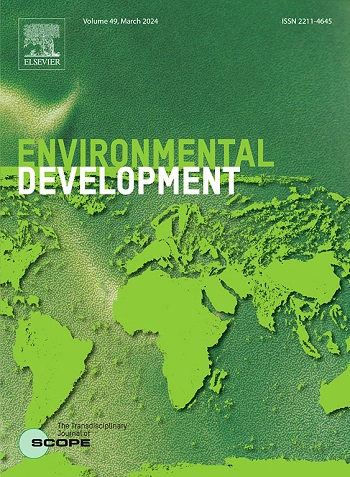Global firestorm: Igniting insights on environmental and socio-economic impacts for future research
IF 5.3
2区 环境科学与生态学
Q2 ENVIRONMENTAL SCIENCES
引用次数: 0
Abstract
Forests are vital life-preserving assets, essential for biodiversity, human health, climate change mitigation, and economic stability. Yet, they are increasingly threatened by forest fires, which undermine these benefits. In the first half of 2025, forest fires in the United States burned over 810,000 acres, Canada lost 7.3 million hectares, while the 2020 Australian mega-fires, which caused an estimated US $20 billion in economic losses, illustrate the scale and urgency of the problem. Despite such impacts, research integrating the diverse dimensions of forest fires, including suppression costs, health effects, tourism, economic impacts, technological advancements, biodiversity, and ecosystem services, remains limited. This study systematically reviews 142 peer-reviewed publications from 2000 to 2023, underscoring the importance of applying theoretical frameworks to practical fire management strategies, bridging the gap between academic insight and real-world application. The findings show that forest fires generate cascading effects on economic growth, ecological services, biodiversity, human health, and macroeconomic stability, all critical for achieving sustainable development goals. Persistent research gaps include the scarcity of region-specific long-term studies, limited integration of opportunity costs into economic assessments, insufficient attention to chronic health impacts, lack of socio-ecological evaluations, minimal empirical work on indigenous populations, and inadequate practical assessment of fire management technologies. Addressing these gaps require investigation into demographic outcomes such as infant mortality and female fertility rates, adoption of advanced valuation methods including the Replacement Cost Method and the Avoided Cost Method, and systematic study of climate–fire feedback loops to ensure theoretical models are effectively translated into actionable strategies for sustainable development and resilience.
全球风暴:点燃对未来研究的环境和社会经济影响的见解
森林是维持生命的重要资产,对生物多样性、人类健康、减缓气候变化和经济稳定至关重要。然而,他们越来越多地受到森林火灾的威胁,这破坏了这些好处。2025年上半年,美国的森林火灾烧毁了81万英亩,加拿大损失了730万公顷,而2020年澳大利亚的特大火灾造成了约200亿美元的经济损失,说明了问题的规模和紧迫性。尽管有这些影响,综合森林火灾不同方面的研究,包括扑灭成本、健康影响、旅游、经济影响、技术进步、生物多样性和生态系统服务,仍然有限。本研究系统回顾了2000年至2023年间142篇同行评审的出版物,强调了将理论框架应用于实际火灾管理策略的重要性,弥合了学术见解与现实应用之间的差距。研究结果表明,森林火灾对经济增长、生态服务、生物多样性、人类健康和宏观经济稳定产生了级联效应,这些都对实现可持续发展目标至关重要。持续存在的研究差距包括缺乏特定区域的长期研究,将机会成本有限地纳入经济评估,对慢性健康影响的关注不足,缺乏社会生态评估,关于土著人口的经验工作很少,以及对火灾管理技术的实际评估不足。解决这些差距需要调查人口统计结果,如婴儿死亡率和女性生育率,采用包括重置成本法和避免成本法在内的先进评估方法,并系统研究气候-火灾反馈回路,以确保理论模型有效转化为可持续发展和复原力的可操作战略。
本文章由计算机程序翻译,如有差异,请以英文原文为准。
求助全文
约1分钟内获得全文
求助全文
来源期刊

Environmental Development
Social Sciences-Geography, Planning and Development
CiteScore
8.40
自引率
1.90%
发文量
62
审稿时长
74 days
期刊介绍:
Environmental Development provides a future oriented, pro-active, authoritative source of information and learning for researchers, postgraduate students, policymakers, and managers, and bridges the gap between fundamental research and the application in management and policy practices. It stimulates the exchange and coupling of traditional scientific knowledge on the environment, with the experiential knowledge among decision makers and other stakeholders and also connects natural sciences and social and behavioral sciences. Environmental Development includes and promotes scientific work from the non-western world, and also strengthens the collaboration between the developed and developing world. Further it links environmental research to broader issues of economic and social-cultural developments, and is intended to shorten the delays between research and publication, while ensuring thorough peer review. Environmental Development also creates a forum for transnational communication, discussion and global action.
Environmental Development is open to a broad range of disciplines and authors. The journal welcomes, in particular, contributions from a younger generation of researchers, and papers expanding the frontiers of environmental sciences, pointing at new directions and innovative answers.
All submissions to Environmental Development are reviewed using the general criteria of quality, originality, precision, importance of topic and insights, clarity of exposition, which are in keeping with the journal''s aims and scope.
 求助内容:
求助内容: 应助结果提醒方式:
应助结果提醒方式:


